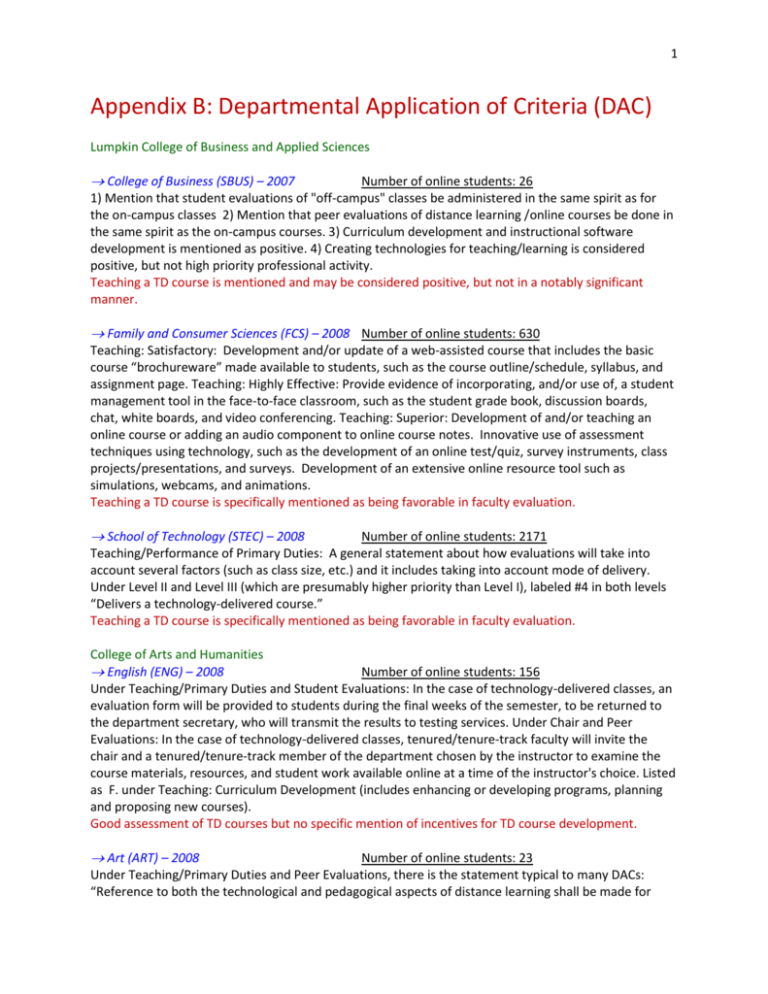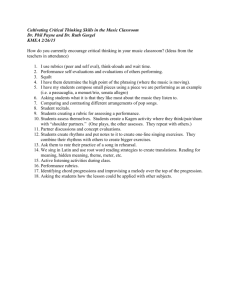Appendix B: Departmental Application of Criteria (DAC)
advertisement

1 Appendix B: Departmental Application of Criteria (DAC) Lumpkin College of Business and Applied Sciences College of Business (SBUS) – 2007 Number of online students: 26 1) Mention that student evaluations of "off-campus" classes be administered in the same spirit as for the on-campus classes 2) Mention that peer evaluations of distance learning /online courses be done in the same spirit as the on-campus courses. 3) Curriculum development and instructional software development is mentioned as positive. 4) Creating technologies for teaching/learning is considered positive, but not high priority professional activity. Teaching a TD course is mentioned and may be considered positive, but not in a notably significant manner. Family and Consumer Sciences (FCS) – 2008 Number of online students: 630 Teaching: Satisfactory: Development and/or update of a web-assisted course that includes the basic course “brochureware” made available to students, such as the course outline/schedule, syllabus, and assignment page. Teaching: Highly Effective: Provide evidence of incorporating, and/or use of, a student management tool in the face-to-face classroom, such as the student grade book, discussion boards, chat, white boards, and video conferencing. Teaching: Superior: Development of and/or teaching an online course or adding an audio component to online course notes. Innovative use of assessment techniques using technology, such as the development of an online test/quiz, survey instruments, class projects/presentations, and surveys. Development of an extensive online resource tool such as simulations, webcams, and animations. Teaching a TD course is specifically mentioned as being favorable in faculty evaluation. School of Technology (STEC) – 2008 Number of online students: 2171 Teaching/Performance of Primary Duties: A general statement about how evaluations will take into account several factors (such as class size, etc.) and it includes taking into account mode of delivery. Under Level II and Level III (which are presumably higher priority than Level I), labeled #4 in both levels “Delivers a technology-delivered course.” Teaching a TD course is specifically mentioned as being favorable in faculty evaluation. College of Arts and Humanities English (ENG) – 2008 Number of online students: 156 Under Teaching/Primary Duties and Student Evaluations: In the case of technology-delivered classes, an evaluation form will be provided to students during the final weeks of the semester, to be returned to the department secretary, who will transmit the results to testing services. Under Chair and Peer Evaluations: In the case of technology-delivered classes, tenured/tenure-track faculty will invite the chair and a tenured/tenure-track member of the department chosen by the instructor to examine the course materials, resources, and student work available online at a time of the instructor's choice. Listed as F. under Teaching: Curriculum Development (includes enhancing or developing programs, planning and proposing new courses). Good assessment of TD courses but no specific mention of incentives for TD course development. Art (ART) – 2008 Number of online students: 23 Under Teaching/Primary Duties and Peer Evaluations, there is the statement typical to many DACs: “Reference to both the technological and pedagogical aspects of distance learning shall be made for 2 distance learning assignments when observed as a required peer evaluation.” Under Student Evaluations, “Items which refer to both the technological and pedagogical aspects of distance learning shall be included on student evaluations for distance learning courses.” No evidence any incentives for TD course development. Theater Arts (THA) – 2008 Number of online students: 3 This department DAC has a whole section (equivalent to whole sections on Teaching, Research, and Service), labeled Distance Learning: Documentation of Materials and Evaluation Criteria. This section is quite thorough and appears well thought through. Although the evaluation of TD courses is given impressive thought, there does not appear to be any real incentives to teach TD courses. History (HIS) – 2008 Number of online students: 199 Under Teaching/Primary Duties: Observations of distance education (online delivery) will reference both technological and pedagogical aspects. Under Student Evaluations: Evaluations of distance education must include both technological and pedagogical aspects as an area of evaluation and be consistent with University (include Approved University Core items) and DAC specifications. Instructors of technology delivered courses may wish to use the secure confidential online student course evaluation option available from the Office of Assessment and Testing that is equivalent to the traditional paper bubble forms. Some effort to address evaluation of TD courses, but no mention of specific incentives. Journalism (JOU) – 2008 Number of online students: 398 Under Teaching/Primary Duties, “Incorporation and use of new and evolving technologies” listed 6th out of 8 items for materials and activities for evaluation of teaching. Could not find any evidence of TD course evaluations or encouragement of TD course development. No hits on word searches on “technology”, “distance”, “web”, “online. Music (MUS) – 2008 Number of online students: 244 Under Teaching/Primary Duties, under items considered for “superior” ranking, item k is “Participating in curriculum revision and development including activities such as proposing a course that is approved by the Music Department and College of Arts and Humanities curriculum committees.” Under Student Evaluations: “Participating in curriculum revision and development including activities such as proposing a course that is approved by the Music Department and College of Arts and Humanities curriculum committees.” Under Peer Evaluations: “Peer evaluations for distance learning courses will address technological and pedagogical aspects of the course.” No evidence of any incentives given for developing TD courses. Communication Studies (CMN) – 2008 Number of online students: 255 Under Categories of Material and Methods of Evaluation, it basically lays out that an online course should be evaluated as equivalent to a face-to-face course with regards to what materials and methods will be used to evaluate the faculty member. There is some mention of development of curriculum as being part of the material considered for teaching evaluation. However, no evidence of web-based learning being encouraged or rewarded in any special way. Philosophy (PHI) – 2008 Number of online students: 311 3 Under Teaching/Performance of Primary Duties, item A (Peer Evaluations): “Reference to both the technical and pedagogical aspects of distance learning shall be made for distance learning assignments reviewed by peers.” Under item B (Student Evaluations): “Course evaluations equivalent to the traditional paper form will be used in technology-delivered courses.” and “Items which refer to both the technological and pedagogical aspects of distance learning shall be included on student evaluations for distance learning courses.” There is a general statement under item E about “Program Development”: “The candidate may submit to the DPC any material relevant to program development involving the philosophy department. This may include course proposals, CAHCC or CAA minutes or other relevant materials.” Some mention of dealing with evaluation of online courses, but no particular incentives evident. College of Sciences Psychology (PSY) – 2008 Number of online students: 895 "In each of the areas of review (teaching/primary duties; research; service) the activities specifically listed shall be regarded as of primary importance…" Under teaching/primary duties, there is a statement about student evaluations that faculty use must, for distance learning courses, include items that refer to both the technological and pedagogical aspects of distance learning. Under peer review of teaching: "Reference to both the technological and pedagogical aspects of distance learning shall be made for distance learning assignments reviewed by peers". Faculty may "documentation of innovative teaching methods and materials..." Under Part C, which is described as being of the lowest priority, "Attendance at workshops and conferences pertaining to professional development in teaching." and "Application of technology in the teaching and learning process". No particular incentives here for development of TD courses. Political Science (PLS) – 2008 Number of online students: 656 Could not find any reference to the words “technology”, “distance”, or “online” or “online”. Casual review of the DAC did not find any references to TD courses. Sociology (SOC) – 2008 Number of online students: 710 “In assessing teaching effectiveness… Reference to both the technical and pedagogical aspects of distance learning shall be made for distance learning assignments reviewed by the chair and a tenured faculty member of the department.” Under Teaching/Performance of Primary Duties: Category of Materials: Items listed in order of importance. “Development of technology-delivered instruction (web courses).” is listed as item f. (6th) out of 9 items. Under Evaluation section: “Any faculty member who develops and teaches a web-based course is expected to provide summary documentation of work to develop those courses. Electronic delivery of student evaluation instrument is accommodated by Testing and Assessment, and all faculty teaching online courses will avail themselves of this opportunity. Web Course instructors will provide a tenured faculty member of the department and chair with their course syllabus and examples of their tests as well as electronic access to the course so that at least one class/lesson may be visited electronically to evaluate the class.” Development of web-based courses mentioned for evaluation purposes, but not given any unusual priority or incentives. Evaluation of web course quality is addressed. Geology-Geography (GEL/GEG) – 2008 Number of online students: 357 (all under GEL) Under Supporting Materials for Teaching/Primary Duties: a list (which DAC states is in decreasing order of importance) consisting of items a through n lists “c. development and implementation of unique programs d. new course development e. curriculum development material.” Under Peer Evaluations of teaching: “In the case of online technology delivered courses, faculty must provide the DPC and 4 department chair access to web-sites and course materials.” For collecting evaluations from students: “Technology delivered (i.e. online) courses will be evaluated using the Purdue evaluation form or an equivalent university instrument. The forms, along with a self-addressed postage paid envelope will be mailed to students by the department secretary. This process will remain in effect until online course evaluation procedures are developed and implemented. Faculty teaching technology delivered courses shall include instructor selected items relevant to both the technological and pedagogical aspects of their courses.” No particular incentives mentioned for development of online courses (except the fairly high priority given to a generic mention of new course or curriculum development). Physics (PHY) – 2008 Number of online students: 363 Under Methods of Collecting Documentation: A. Student Evaluations: “Student evaluations in technology-delivered courses shall be considered relative to the level of technological support/ reliability and performance quality of the hardware and software used, and in the context of general student response to distance education versus face-to-face classroom instruction.” B. Physics Department Faculty and Chair Teaching Evaluation Report: “Evaluators shall refer to both the technological and pedagogical aspects of distance learning for distance learning assignments.” “In the case of technology-delivered courses, that is, a course in which face-to-face interaction is not the predominant mode of instruction, the classroom visit may be replaced by observation of course activities using the course web site (or whatever mode of delivery is used), such as discussion groups, chat rooms, and posted materials.” Under Categories of Teaching Documentation, developing a new course is listed as item b. in Type I activities and enhancing technology use is listed as item f. in Type 2 activities. Development of new courses given a fairly high priority, but no emphasis on web-based courses. Fairly careful consideration of evaluation of technology-delivered courses. Nursing (NUR) – 2008 Number of online students: 226 Under Teaching I Performance of Primary Duties and I. Categories of Materials and Activities for Evaluation of Teaching / Performance of Primary Duties: Development of new courses is listed as #3 out of 15 items in category B, the lower priority category. Under Methods of Evaluation of Teaching…, subsection 4. there is mention of submitting materials for distance/online/electronic materials for evaluation and “Narrative description of methodologies utilized (active learning, technology)”. Development of website materials is listed as item #10 in section A. under evaluation of Research/Creative Activity. No evidence of any particular incentives for online course development. Biological Sciences (BIO) – 2008 Number of online students: 576 Under Teaching/Performance of Primary Duties, Categories of Materials and Activities: Item c is “Course/curriculum development, e.g., new study abroad or on-campus courses developed & implemented, development of new technology for use in instruction” and item g is “Course/curriculum improvement, (e.g, new laboratory exercises developed, incorporation of new technology into instruction)”. There is also the (common) inclusion of a statement about considerations for student evaluations of distance-education courses. The student evaluation form does include a question asking students if the instructor is available “electronically” for distance-education classes and the department does require an extra question on the student evaluation form for distance-education classes: “11. Please evaluate the technology (server access, interacting with other students, etc.) used to deliver your technology-delivered course section.” 5 There appears to be a slightly better emphasis on curriculum development than in other DACs, but still no particular incentives here for development of TD courses. There also appears to be at least a marginally more deliberate attempt to evaluate the quality of any TD courses. Communication Disorders and Sciences (CDS) – 2008 Number of online students: 16 Under Teaching/Performance of Primary Duties, Level 2 (for highly effective rating), item c is “Highly effective use of technology and innovative teaching techniqes which enhance the learning process.” item f is “Curriculum revision, curriculum development, or development of teaching assignments.” Level 3 (superior) has a similar item c “Superior use of technology and innovative teaching techniques which enhance the learning process.” but no analog to item f from Level 2. Under Student Evaluation Procedures, there is a typical statement about distance learning evaluations: “In evaluating distance learning courses, both technological and pedagogical aspects shall be included in student evaluations.” This same statement is used in the Chair and tenured faculty evaluation of tenure-track faculty and Unit B faculty. Another statement regarding evaluations: “It should be recognized that teaching evaluations might be affected by the rigor of a course or technological issues in distance learning courses. In applying these guidelines, evaluators should, therefore, recognize that new course preparation, teaching methods/traits and technological difficulties may affect evaluations.” There is some encouragement for curriculum development and use of technology in the teaching section. No direct references to incentives for online course development. Careful placement of statements about considering distance learning challenges in evaluating faculty. Economics (ECN) – 2008 Number of online students: 71 Under Teaching/Performance of Primary Duties, Categories of Materials and Activities, Student Evaluations, is a typical statement about taking into account special circumstances for student evaluations of distance learning: “Items which refer to both the technological and pedagogical aspects of distance learning shall be included in student course evaluations for distance learning courses.” In the same area of the DAC, under Other Documentation, there is “The faculty member may submit other materials in support of teaching effectiveness such as samples of course syllabi, examinations and class materials, teaching awards or recognition and contributions to the development or revision of curriculum. Such material is particularly encouraged in so far as it pertains to i)Application of technology in the teaching and learning process; ii)Participation on an interdisciplinary, interdepartmental and/or intercollegiate basis; iii)Participation in instructional and/or outreach activities including student engagement and mentoring, recruitment, or off-campus instruction.” In the same area of the DAC (teaching) and Methods of Evaluation is “In assessing teaching effectiveness, evaluators shall consider such factors as 1) the size of the class; 2) the level of the class (lower division, upper division, graduate); 3) required or elective status; 4) whether the students are primarily majors in economics, business, or some other discipline; 5) innovative technique and course development; and 6) application of technology in the teaching and learning process. Reference to both the technological and pedagogical aspects of distance learning shall be made for distance learning assignments reviewed by peers and the chair.” There is some effort to encourage innovative use of technology and engagement of off-campus students. No extraordinary emphasis on TD course development, but a slightly more noticeable effort than in “typical” DACs. College of Education and Professional Studies Educational Administration (EDA) or Educational Leadership – 2008 Number of online students: 35 Under “Classroom Visitations” under peer evaluation of teaching: “The technological and pedagogical aspects of distance learning shall be considered for distance learning assignments.” Under “student 6 evaluations”: “Items which refer to both technological and pedagogical aspects of distance learning shall be included on student evaluations for distance learning courses.” Under “course materials”: “For distance education, assignments and assessments are to be specified in course syllabi.” and “Distance education materials (such as assignments, assessments, and web sites) will be available to the DPC for review.” Some care taken in evaluating faculty that are teaching distance education courses, but no particular incentives here for development of TD courses. Health Studies (HST) – 2008 Number of online students: 199 Under Teaching/Primary Duties and Categories of Materials and Activities – Group B (Highly Effective, h): Application of technology in the teaching and learning process. Group C – Superior: k) New course development, modifying existing courses or developing technology delivered courses ) Innovative use of assessment techniques using technology, such as the development of an online test/quiz, survey instruments, class projects/presentations, and surveys. Under Methods of Evaluation: 3. Student evaluations for Technology-Delivered Courses must be submitted using the University approved online Technology-Delivered Course Evaluation. Specific mention of development of TD courses under the “Superior” category, although not given a higher priority than other listed items. Secondary Education (SED) – 2008 Number of online students: 653 Under Teaching/Primary Duties and Categories of Materials and Activities Materials Part D: Services Provided to Support Teaching “integration of technology in the Classroom (including distance learning)”. Under Methods of Assessment: “Peers will evaluate distance learning courses based on both technological and pedagogical criteria.” Under Student Evaluations: “For distance learning courses, additional items must refer to both pedagogical and technological aspects of distance learning.” Under “Other Professional Service” : “participation in service or technology projects.” Some care taken in evaluating faculty that are teaching distance education courses, but no particular incentives here for development of TD courses. Kinesiology and Sports Studies (KSS) – 2008 Number of online students: 142 (KSS) + 109 (PED) = 251 Under Teaching/Performance of Primary Duties – Peer Evaluation: “In the case of technology delivered courses, that is, a course in which face-to-face interaction is not the predominant mode of instruction, the classroom visit may be replaced by observation of course activities using the course web site (or whatever mode of delivery is used), such as discussion groups, chat rooms and posted materials.” Under Teaching/Performance of Primary Duties – Additional Documentation: “Use of technology and innovative teaching techniques which enhance the learning process.” and “Course and curriculum development or revision.” Appears to be at least moderately more encouraging of technology-based course development than most other DACs Counseling and Student Development (CSD) – 2008 Number of online students: 114 Under Teaching/Performance of Primary Duties, Documentation, Supporting Evidence of Teaching Effectiveness…: Item 5 (out of 11 items) is “Exceptional use of technology integrated into teaching/primary duties (e.g., web enhanced course design, resources for learning, etc.).” Item 8 is “New course development and implementation.” No evidence of any incentives for TD course development.






